North Central Climate Adaptation Science Center Regional Science Plan—2023–28
Links
- Document: Report (5.40 MB pdf) , HTML , XML
- Download citation as: RIS | Dublin Core
Acknowledgments
This report reflects the collaborative effort of the staff and partners of the U.S. Geological Survey (USGS) North Central Climate Adaptation Science Center. Special thanks to Molly Cross (USGS, formerly Wildlife Conservation Society) and Shelley Crausbay (U.S. Department of Agriculture Forest Service, formerly Conservation Science Partners) for collecting and analyzing the majority of the partner input used to develop the science priorities. Multiple individuals contributed to the content of this report in different capacities, listed in alphabetical order by last name: Aparna Bamzai-Dodson (USGS), Nadine Golden (USGS), Katherine Kurth (Oak Ridge Institute for Science and Education Research Participation Program), Meagan Oldfather (USGS), Robin O’Malley (retired, formerly USGS), Stefan Tangen (USGS, formerly Great Plains Tribal Water Alliance), Alisa Wade (U.S. Department of the Interior, formerly USGS), and Kynser Wahwahsuck (Great Plains Tribal Water Alliance).
Abstract
The U.S. Geological Survey North Central Climate Adaptation Science Center (NC CASC), established in 2012, is part of a national network supporting climate-informed decisions that benefit wildlife and habitats. The NC CASC provides climate science for the U.S. Department of the Interior, State agencies, and Tribal nations to support effective resource management. Collaborating with the National and Regional Climate Adaptation Science Center network, the NC CASC addresses multiregion challenges through a partnership involving the U.S. Geological Survey and additional regional partners. Input is collected from an Advisory Committee of State, Federal, and Tribal Government representatives. The center hosts Tribal Climate Resilience Liaisons, which are funded by the Bureau of Indian Affairs Branch of Tribal Climate Resilience and aligned with a Tribal Engagement Strategy.
Positioned at the meeting point of scientists and managers and guided by core values, the NC CASC studies diverse ecosystems affected by climate change and empowers resource managers with actionable data and innovative science. This report outlines the 5-year Science Plan (hereafter “the Plan”) for the NC CASC. The center uses stakeholder engagement and coproduction of knowledge for effective collaboration, including engagement of Advisory Committee members and other management partners in the development of the Plan. The Plan provides a high-level overview of the NC CASC, covering the center’s geographical scope, key collaborators, stakeholders, and the strategic framework guiding the application of climate science to make informed management decisions. The Plan also summarizes management challenges and scientific objectives related to the impact of climate change on habitat, ecological drought, wildlife disease, invasives and encroachment, fire, and phenology.
Introduction
Changing environmental conditions have increased demands for scientific support as managers seek to understand potential effects on their resources and to identify adaptation strategies. The U.S. Geological Survey (USGS) North Central Climate Adaptation Science Center (NC CASC; https://nccasc.colorado.edu/) was established in 2012 as part of a national network of regional centers intended to support climate-informed decision making about fish and wildlife, their habitats, and the many benefits people derive from these systems (fig. 1). On March 23, 2018, the name of the regional Climate Science Centers was changed to the Climate Adaptation Science Centers when the U.S. Congress passed the fiscal year 2018 budget. The name of the National Climate Change and Wildlife Science Center, which manages the regional centers, was changed to the National Climate Adaptation Science Center. The following sections describe the organization and operations of the NC CASC, the partners that it serves, and its approach to actionable science.
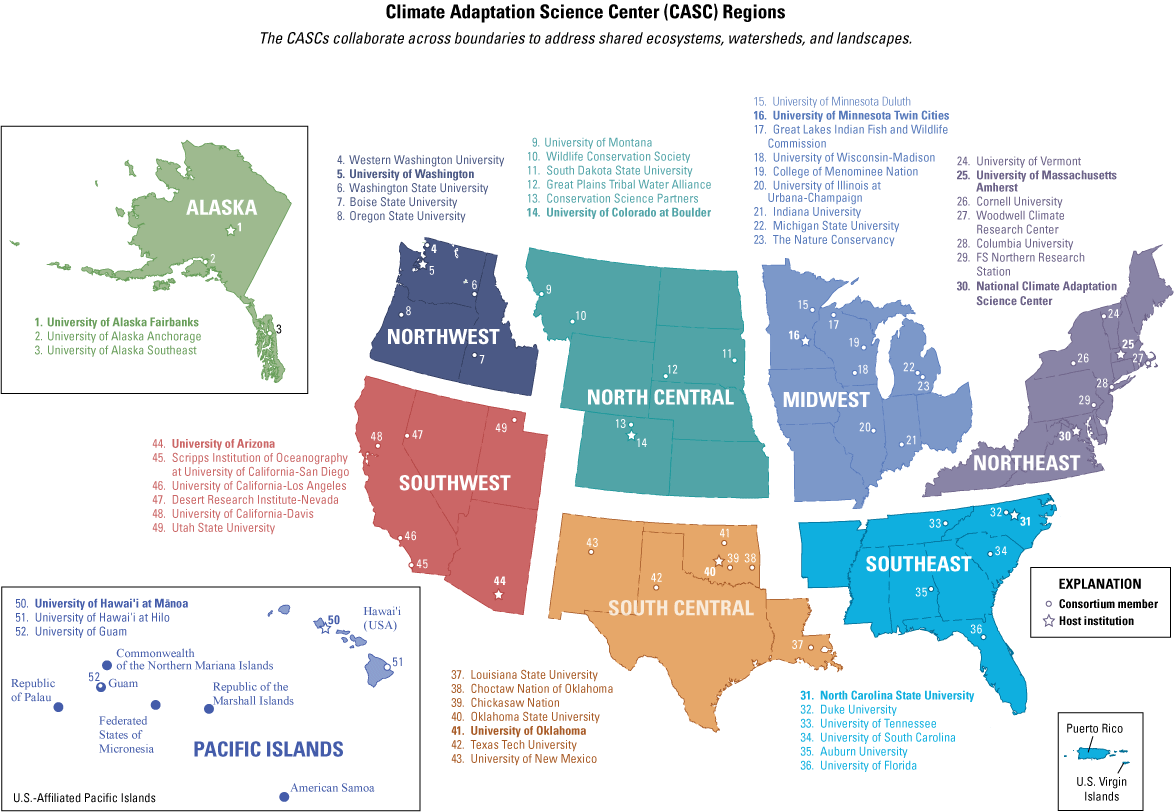
The National Climate Adaptation Science Center and regional Climate Adaptation Science Centers’ host institutions and consortium members in the United States, affiliated Pacific islands, and associated territories.
Organization and Operations
The NC CASC supports scientific needs across the States of North Dakota, South Dakota, Nebraska, Kansas, Colorado, Wyoming, and Montana (fig. 2; also referred to as the “North Central region”) and works closely with the National Climate Adaptation Science Center (CASC) and regional CASC network to address multiregional issues. The NC CASC is a joint enterprise involving the USGS and the University of Colorado (CU) Boulder as primary partners and includes a consortium of five additional academic and nongovernmental partners: Conservation Science Partners, Great Plains Tribal Water Alliance, South Dakota State University, the University of Montana, and Wildlife Conservation Society.
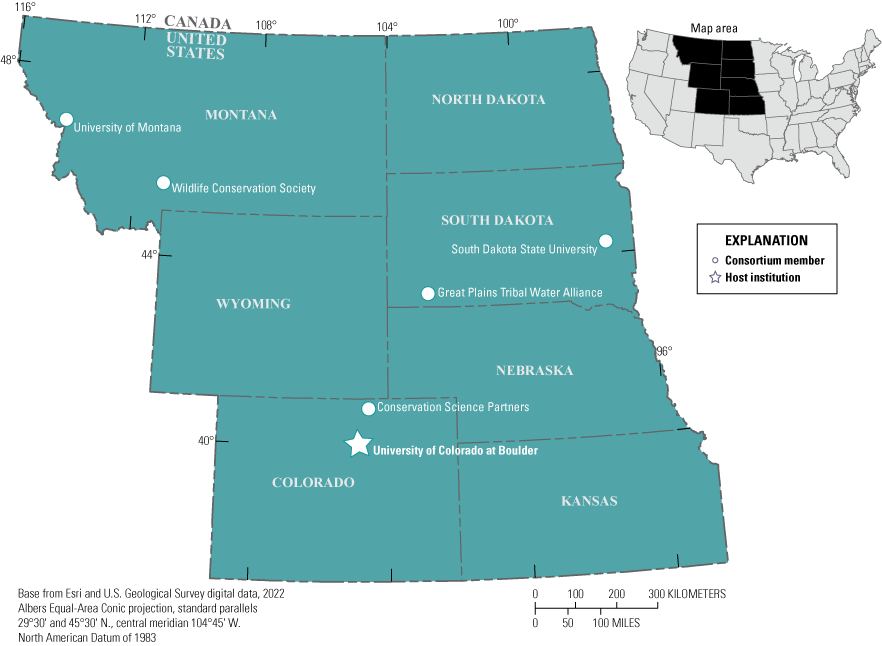
Map showing the host and consortium institutions for the seven States in the North Central region that are serviced by the North Central Climate Adaptation Science Center.
The NC CASC is jointly managed by a USGS regional administrator and a university director and includes Federal- and university-supported programs and scientific staff and students. The multiyear cooperative agreement between USGS and the university host is periodically recompeted (in other words, up for renewal) through a competitive request for proposals process (https://www.usgs.gov/programs/climate-adaptation-science-centers/casc-host-recompetition). In 2018, CU Boulder was selected to serve as the NC CASC host until 2024, along with the named consortium members. Input on priorities and the usefulness of the NC CASC’s science is provided by an Advisory Committee composed of State, Federal, and Tribal Government representatives (https://nccasc.colorado.edu/partners/stakeholder-advisory-committee).
The NC CASC hosts two Tribal Climate Resilience Liaisons, funded by the Bureau of Indian Affairs Branch of Tribal Climate Resilience (https://www.bia.gov/bia/ots/tcr) and employed by the Great Plains Tribal Water Alliance (http://www.tribalwateralliance.org/). The Tribal Climate Resilience Liaisons have a lead role at the NC CASC for communicating with Tribes, identifying challenges and needs, and ensuring strong working relations. The liaisons foster dialogue with Tribal partners and work collaboratively to identify appropriate roles, products, and services that can benefit Tribal communities. Work conducted by the liaisons is guided by a regional Tribal Engagement Strategy (NC CASC, 2023), and inclusion of Indigenous knowledge must respect and protect data sovereignty.
The NC CASC is uniquely placed at the intersection of scientists and managers working to support resilient ecosystems. The NC CASC vision for the future is that natural and cultural resource managers use actionable and open data, tools, and innovative science and information to make climate-informed decisions that support resilient ecosystems.
Partners Served by the North Central Climate Adaptation Science Center
The diverse landscape of the North Central region includes a variety of ecosystems and wildlife affected by climate change that range from the alpine ecosystems of the Rocky Mountains to the grasslands of the Great Plains. The NC CASC provides climate science and adaptation information to support climate-informed natural and cultural resource management planning and decision making primarily by bureaus of the U.S. Department of the Interior (DOI), State fish and wildlife agencies, and Tribal nations (fig. 3). Although these entities form the core users and beneficiaries, the NC CASC uses an “all lands and waters” approach that focuses on fish and wildlife, their habitats, and the benefits people receive from them. The NC CASC also recognizes that other entities are often important partners in specific places; for example, there can be opportunities for coordinated resource planning and management where U.S. Department of Agriculture and DOI lands are adjacent to one another.

Graphic showing priority partnerships for the North Central Climate Adaptation Science Center. DOI, U.S. Department of the Interior.
The NC CASC collaborates with and seeks input from other academic and public science partners, conservation organizations, and not-for-profit groups in the region, such as grazing associations. Information developed by the NC CASC can also be useful to private landowners, municipalities, and other local entities. Although these partners may not have direct public land and resource management responsibilities, they do have important contributions to make toward framing problems and identifying solutions. The NC CASC collaborates with individuals and organizations, specializing in outreach and extension, to ensure information is accessible to these partners and integrated with other relevant guidance. The NC CASC strives to incorporate people and communities in all activities so that they are fully considered in resource decision making.
The NC CASC builds partnerships with and follows the climate adaptation leadership of Tribal nations in the region. Federally recognized Tribes are sovereign governments with substantial legal and traditional resource management roles. Tribal nations are often challenged by intense competing priorities, resource limitations, and legal constraints. The DOI has a major role in relations between the U.S. Government and Tribal nations, and the work of the NC CASC supports that fiduciary role. The NC CASC seeks to foster a continuing dialogue with Tribal nations and inter-Tribal organizations in the region to identify resource challenges that may benefit from climate-related science, capacity building, convening, and similar activities. The NC CASC recognizes that each Tribe has unique challenges and needs that are dependent on their individual historical and contemporary circumstances. The NC CASC strives to integrate consideration of Tribal needs into each priority and objective in a culturally appropriate way and to respect, uphold, and protect Tribal sovereignty.
Approach to Actionable Science
The primary objective of the NC CASC is to produce science that is directly usable in making resource management plans and decisions; that is, the science is actionable. Actionable science is described as providing “data, analyses, projections, or tools that can support decisions regarding the management of the risks and impacts of climate change” (Advisory Committee on Climate Change and Natural Resource Science and Meridian Institute, 2015, p. 13). The NC CASC does not make, recommend, or endorse specific decisions, policies, or actions. Rather, the NC CASC seeks to proactively and intentionally engage with stakeholders to identify and satisfy information needs. These needs are often related to high-priority resource management decisions or actions that may be impacted by climate variability and change. This engagement covers a continuum of possible interactions with stakeholders, spanning from communication of results to coproduction of science, whereby stakeholders are an integral part of the science team (for more information, refer to the following USGS-produced short video regarding stakeholder engagement for actionable science: https://youtu.be/5_OW0kAJIzk).
Science activities conducted by the NC CASC include original research and synthesis and translating existing scientific information into management-relevant formats. Facilitating effective use of science for management involves a broad suite of support activities, such as the following (fig. 4):
-
● Partnerships with regional stakeholders and rights holders that enable the NC CASC to respond to high-priority natural and cultural resource management challenges and to facilitate substantive, sustained engagement between scientists and managers.
-
● Capacity building that creates a community of skilled researchers and managers and fosters their leadership in science-based resource management.
-
● Development of climate tools and means of technical assistance that advance scientific understanding of the impacts of climate change, support sound resource management and adaptation, and evaluate the effectiveness of adaptation measures by assessing the expected outcome.
-
● Communication of NC CASC science so that it is accessible and usable.

Graphic showing science-support activities of the North Central Climate Adaptation Science Center.
Science Challenges and Priorities
Resource managers and local communities face a variety of climatic impacts associated with warming temperatures and changing precipitation patterns. The following sections describe climate challenges specific to ecosystems in the North Central region, the process by which partner needs related to climate and resource management were identified, and the resulting priorities and objectives for NC CASC science and activities.
Climate Challenges of North Central Region Ecosystems
Changes in the climate system are resulting in changes to regional physical and biological processes such as hydrologic cycles, primary production, disease transmission, and migration patterns. Although people and ecosystems across the North Central region have adapted to past climate challenges, the magnitude, rate, and impacts of expected changes may exceed those previously experienced changes.
Precipitation across the North Central region has changed; precipitation has decreased in the western and southwestern parts of the region and increased in most of the northern and southern parts (Crimmins and others, 2023). These changes affect snowpack, streamflow, and water availability (such as in the Missouri River, one of the region’s primary freshwater arteries) and in downstream regions (such as the Rio Grande Basin; fig. 5). Precipitation is forecasted to remain highly variable in the future, and a shift toward more arid conditions is likely in the southwestern States in the North Central region (Crimmins and others, 2023).
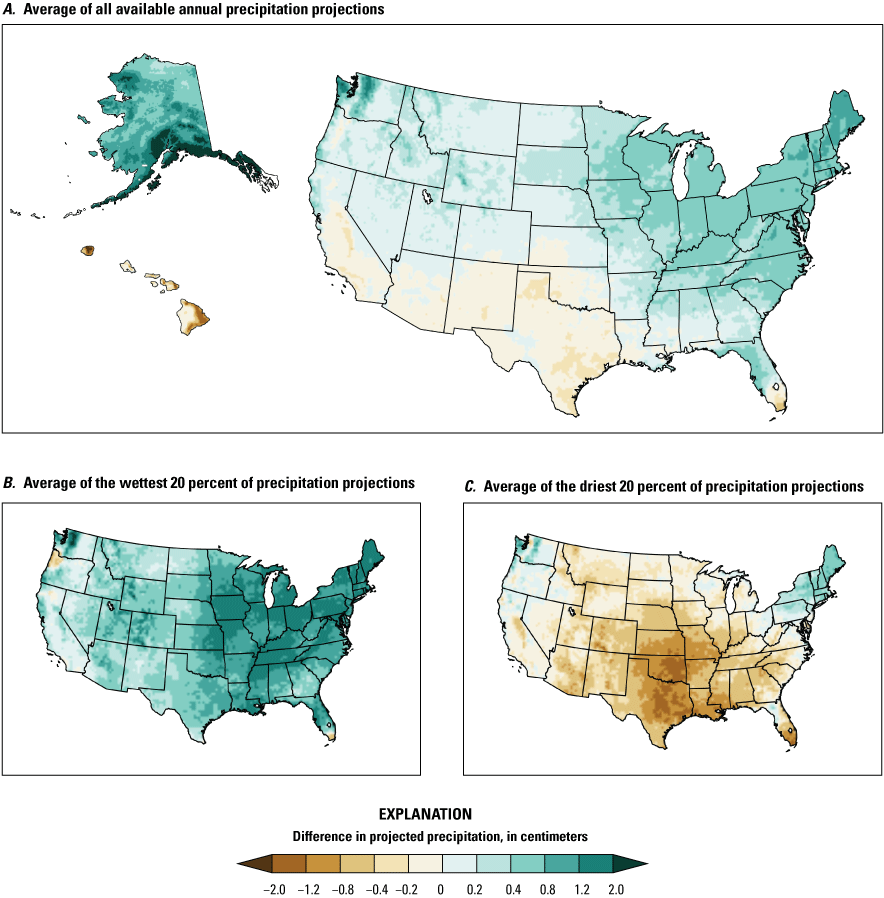
Maps showing the Fifth National Climate Assessment projections of annual precipitation (in centimeters) changes by midcentury (2036–65 relative to 1991–2020) under an intermediate emissions scenario. A, Annual average precipitation is projected to increase for the North Central region, although the B, wettest 20 percent of projections and C, driest 20 percent of projections demonstrate the range of uncertainty. Modified from Crimmins and others (2023).
Temperatures have increased throughout the North Central region and are expected to continue to rise (Crimmins and others, 2023). Hotter temperatures will have direct effects on regional drought and indirectly increase the likelihood of drought conditions across larger parts of the region. Changes in temperatures and precipitation have led to more intense disturbances and severe weather events, such as increases in flooding, incidence of large forest fires, and intensity of drought in some areas (Crimmins and others, 2023). This variability of the climate is predicted to increase with future climate change (Crimmins and others, 2023). These and related trends have and will continue to affect the landscape and ecosystems and have varying effects on people, fish and wildlife, crops, and other resources of human and ecological value. Climate-change impacts will vary across the ecosystems in the North Central region and may lead to unique management challenges and research opportunities.
Ascertaining Partner Needs
The NC CASC has taken on and will continue to perform activities intended to elicit information on the climate adaptation needs of partners in the region. These activities include the following:
-
● A short survey sent out broadly to NC CASC partners and stakeholders in 2018, accompanied by a series of webinars.
-
● A funded project, “Enabling Climate-Informed Planning and Decisions about Species of Conservation Concern in the North Central Region—Phase 1,” to systematically identify climate-related information gaps that, if addressed, would support State fish and wildlife agencies and Federal resource management decisions within the North Central region. This project included a series of semistructured interviews with State fish and game agency staff and a survey of—and facilitated face-to-face meetings with—key Federal resource management agency partners (https://www.sciencebase.gov/catalog/item/596f58ebe4b0d1f9f0645e82).
-
● A Snow Collider virtual event in 2020 that brought together scientists and natural resource managers to discuss snow-related data and information needs, model limitations, and potential next steps for modeling future snow projections (https://nccasc.colorado.edu/sites/default/files/2020-08/2020%20June%2011%20Snow%20Collider%20Summary.pdf).
-
● Virtual listening sessions in 2021 on “Fire in Forests and Grasslands” (https://nccasc.colorado.edu/sites/default/files/2021-06/NC%20CASC%20%26%20Hub_JSC%20Future%20of%20Fire_Summary.pdf) and the “Future of Grasslands Management” (https://nccasc.colorado.edu/sites/default/files/2022-03/NC%20CASC%20%26%20Hub_JSC%20Grasslands_Summary%20Aug%202021.pdf) to connect with Advisory Committee members and learn about their climate-related priorities regarding these topics.
-
● Ongoing in-person and virtual Tribal-engagement activities by the Tribal Climate Resilience Liaisons (https://nccasc.colorado.edu/resources/tribal-partners).
Through these engagement activities, resource managers prioritized four regional ecosystems (refer to the “Science Priorities and Objectives” section) and identified important climate-related challenges to natural resource management. Similar management issues were identified across multiple ecosystems, leading to the development of six key management priorities (refer to the “Science Priorities and Objectives” section). The ecosystems are inherently linked, and the management issues are critically connected through the ecology of the ecosystems. Thus, resource managers expressed a need to focus on the mechanisms and interactions that support ecosystem function to accomplish management goals, even when addressing the needs of individual species.
Science Priorities and Objectives
Based on the priorities identified by management partners, the NC CASC intends to focus its science on the following six cross-cutting management issues across the next 5 years: habitat loss, connectivity, and transformation; water availability and drought; wildlife disease; invasives and encroachment; wildfire; and phenology (“the pattern of seasonal life-cycle events in plants and animals”; Crimmins and others, 2023). These management issues represent physical or structural properties, ecological processes, or disturbances that have the potential to transform the ecosystems and associated habitats of concern (fig. 6). Emphasis will likely be placed on science involving four priority ecosystems: freshwater and riparian, grasslands, Artemisia L. (sagebrush) steppe, and mountainous.
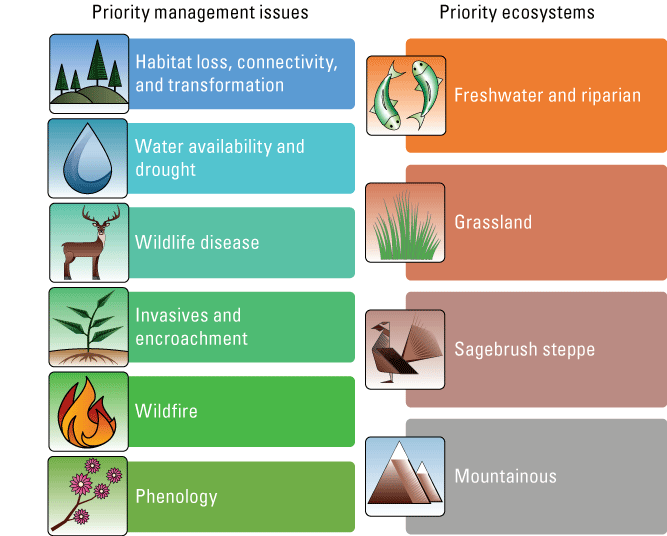
Six priority management issues and four priority ecosystems on which the North Central Climate Adaptation Science Center plans to focus its science from 2023 to 2028.
Freshwater and riparian ecosystems rely on water resources to support their diversity of flora and fauna and can include aquifers, ponds, lakes, rivers, drainage ways, streams (permanent and ephemeral), and the contiguous riparian landscapes shaped by these surface and subsurface hydrologic features. Grasslands are a varied ecosystem type dominated by grasses that also contain a diversity of nongrass plant species. Within the North Central region, grasslands include tall, short, and mixed grass prairies; grasslands have been severely reduced in geographic area and transformed because of agriculture, grazing, and changing fire regimes (the pattern of how, when, where, and why fires occur; Krebs and others, 2010). Sagebrush steppe includes areas dominated by sagebrush, other shrubs, and perennial grasses; these “seas of sagebrush” host a diversity of protected vertebrate species and form transition zones with grasslands. Mountainous ecosystems include alpine, subalpine, montane meadow, and forested ecosystems with high terrain diversity (for example, large changes in elevation, slope, and aspect) and, in the North Central region, encompass the Rocky Mountains and the lower elevation Black Hills. Figure 7 represents the presence of each ecosystem type across the North Central region.
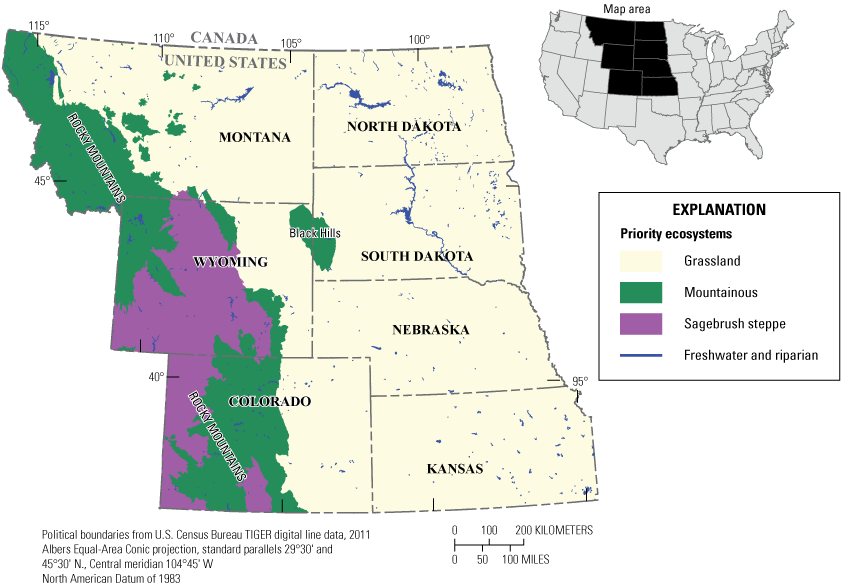
Map showing priority ecosystem areas that were determined by the U.S. Environmental Protection Agency Level III Ecoregions (Omernik and Griffith, 2014) and coarsely represent areas with biotic conditions suitable for each ecosystem type. Freshwater areas were mapped using the U.S. Geological Survey National Hydrography Dataset (U.S. Geological Survey, 2023) and subsetting to waterbodies greater than 3 square kilometers and rivers greater than 2 kilometers in length.
The NC CASC anticipates particularly strong actionable science opportunities focused on the following management issues in specific priority ecosystems: ecological drought in freshwater and riparian systems, mountains, and sagebrush steppe; invasive, nonnative species in freshwater, riparian, and grasslands systems; fire in mountains, sagebrush steppe, and grasslands; and phenology in grasslands and sagebrush steppe (particularly shrublands). Research opportunities focused on wildlife disease and habitat loss, connectivity, and transformation are applicable to all priority ecosystems. Figure 8 illustrates the six management priorities and specific scientific objectives associated with each priority.
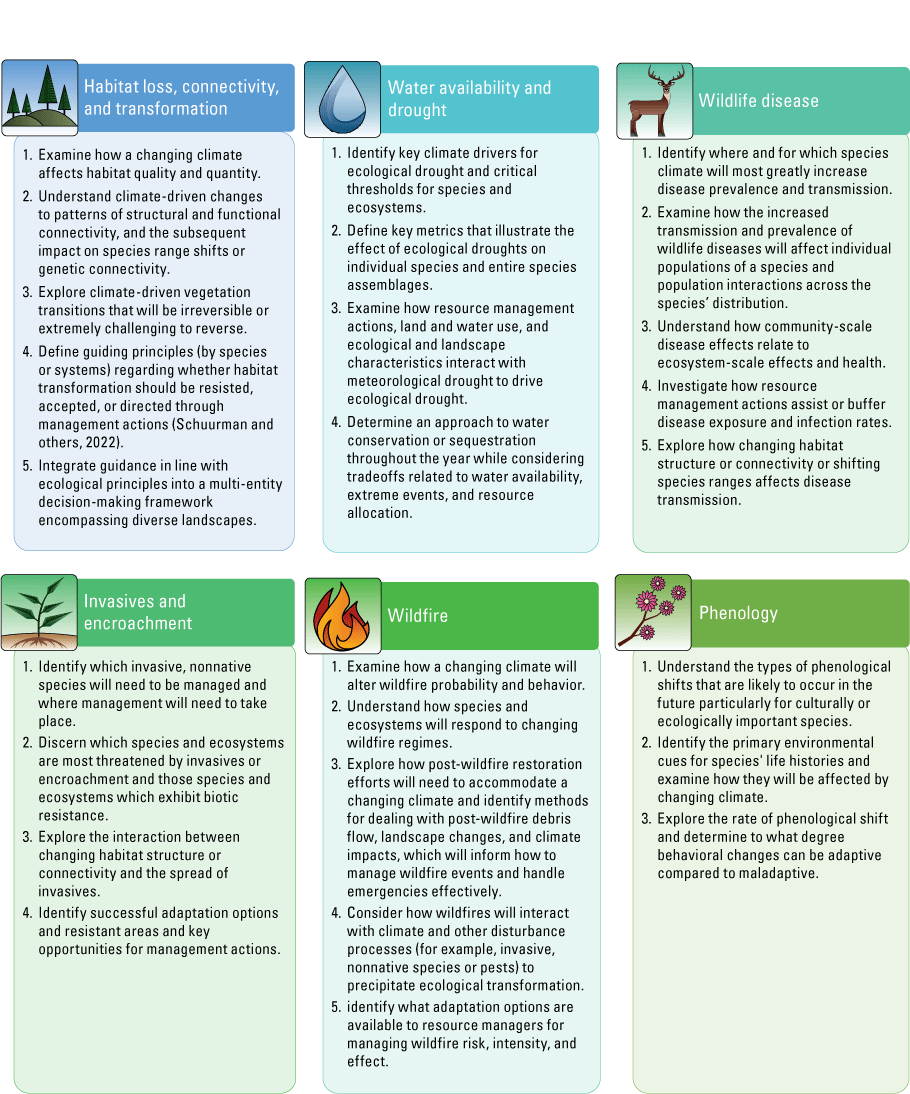
Graphic showing the North Central Climate Adaptation Science Center's six priority management issues and objectives.
Habitat Loss, Connectivity, and Transformation
Climate change can completely transform ecosystems through changes in habitat availability (most commonly because of habitat loss) and connectivity. Habitat loss for a given species represents the reduction in total area or the area of individual patches of habitat. Connectivity represents structural and functional connectivity of habitat patches (the physical arrangement and proximity of patches to one another and the ability for organisms or genes to move between patches) and the connectedness of the landscape that allows for natural processes to occur (such as the degree to which a river is connected to floodplains). Transformation entails the wholesale change of ecosystem composition, structure, and function that affects species, their habitats, and the ecological services provided in that ecosystem. The following are scientific objectives specific to habitat loss, connectivity, and transformation:
-
1. Examine how a changing climate affects habitat quality and quantity.
-
2. Understand climate-driven changes to patterns of structural and functional connectivity and the subsequent impact of climate on species range shifts or genetic connectivity.
-
3. Explore climate-driven vegetation transitions that will be irreversible or extremely challenging to reverse.
-
4. Define guiding principles (by species or systems) regarding whether habitat transformation should be resisted, accepted, or directed through management actions (Schuurman and others, 2020).
-
5. Integrate guidance in line with ecological principles into a multi-entity decision-making framework encompassing diverse landscapes.
The following are example research opportunities specific to habitat loss, connectivity, and transformation:
-
● Provide relevant science and data products in management-ready formats for inclusion in partner decision-making and planning processes related to habitat conservation, restoration, and acquisition.
-
● Explore climate-driven losses of important habitat for species in the region. Specific examples include reductions in the availability of cold-water spawning grounds for Salvelinus spp. (char), reductions in the distribution and structure of Populus spp. (aspen) stands because of increases in temperature and changing precipitation timing and quantity, and reduced availability of Gulo gulo (wolverine) denning sites from changes in snowpack depth and connectivity.
-
● Understand why, how, and when ecosystems change, expanding the information available to managers regarding the likelihood of significant landscape transformation, and identifying more-likely and less-likely areas of refugia (“areas relatively buffered from contemporary climate change over time”; Morelli and others, 2016) and transformation.
-
● Examine the effectiveness of varied management responses under scenarios of future transformation. Specific examples include fire- and invasive-driven conversion of sagebrush to grass-dominated landscapes, expansion and contraction of Pinus spp. (pinyon) and Juniperus spp. (juniper) woodlands, and decreasing establishment of saplings in pinyon forests.
-
● Assist with navigating strategies under the “Resist-Accept-Direct” framework (Schuurman and others, 2020) to manage ecosystems and species of cultural importance to Tribal communities and support robust costewardship partnerships across Tribal and Federal management in areas of mutual concern.
Water Availability and Drought
The NC CASC focuses on ecological drought, which is defined as “the ecosystem-wide response to drought, as opposed to agricultural, hydrological, or meteorological drought” (Crausbay and others, 2017). Ecological droughts, by definition, have large effects on ecological and human systems and can lead to species loss, economic loss, a shift in ecosystem feedback and function, and transformation of ecologically and societally valuable ecosystems. Ecological drought will be driven not only by the exposure to drought conditions but also by the sensitivity and adaptive capacity of systems experiencing the drought conditions. The following are scientific objectives specific to water availability and drought:
-
1. Identify key climate drivers for ecological drought and critical thresholds for species and ecosystems.
-
2. Define key metrics that illustrate the effect of ecological droughts on individual species and entire species assemblages.
-
3. Examine how resource management actions, land and water use, and ecological and landscape characteristics interact with meteorological drought to drive ecological drought.
-
4. Determine an approach to water conservation or sequestration throughout the year while considering tradeoffs related to water availability, extreme events, and resource allocation.
The following are example research opportunities specific to water availability and drought:
-
● Build science knowledge on the primary drivers and threshold responses of ecological drought and how climatic change may alter the frequency and distribution of ecological drought. Assist resource and water managers by developing and distributing tools for predicting and monitoring ecological drought.
-
● Relate projections of future snowpack and snowline to models for high-elevation mountain habitats and connectivity that have direct management implications for species of concern such as wolverine, Lynx spp. (lynx), and Lagopus spp. (ptarmigan).
-
● Develop or expand projections of future streamflow and water temperature for use in resource management, such as the management of recreational fishing, invasive species management and control, water diversion and use, forest planning and revisions, species listing, and habitat designation.
-
● Use the best available tools, such as scenario planning, remote sensing datasets, and Indigenous knowledge, to help resource managers explore options for navigating ecological drought.
Wildlife Disease
Climate-driven migrations and range shifts of pathogens, hosts, and vectors may change population interactions, which affect the transmission and geographic extent of wildlife diseases. Populations affected by disturbance, including disturbance caused by climate change, are more vulnerable to disease emergence and effects. Although challenging, the complexity of disease dynamics, coupled with disease sensitivity to changing climate conditions, creates opportunities for predicting and managing wildlife disease. The following are scientific objectives specific to wildlife disease:
-
1. Identify where and for which species climate change will most greatly increase the transmission of disease agents and prevalence of prioritized wildlife diseases (for example, diseases that are zoonotic, affect livestock, or affect culturally or ecologically important wildlife species).
-
2. Examine how the increased transmission and prevalence of wildlife diseases will affect individual populations of a species and population interactions across the species’ distribution.
-
3. Understand how community-scale disease effects relate to ecosystem-scale effects and health.
-
4. Investigate how resource management actions assist or buffer disease exposure and infection rates to identify the most effective management actions.
-
5. Explore how changes in habitat structure, habitat connectivity, or species ranges affect disease transmission.
The following are example research opportunities specific to wildlife disease:
-
● Investigate strategies to manage population health for increased resilience to disease outbreaks and to prevent and manage disease outbreaks made worse by climate change. Specific examples include chytridiomycosis, brucellosis, chronic wasting disease, and white-nose syndrome.
-
● Develop or expand the evidence base for disease interventions, including examination of their potential unexpected negative consequences on ecosystem health.
-
● Investigate the effects on disease dynamics of assisted migration, translocation, or reintroduction of species; for example, the facilitated movement of temperature-sensitive fish affected by warming water temperatures, such as Salvelinus confluentus (bull trout).
-
● Forecast climate-driven expansion of zoonotic diseases, such as West Nile virus, and examine potential mitigation techniques.
-
● Analyze the susceptibility or exposure to disease and climate impacts for species of cultural importance to Tribal communities, such as subsistence fish and game, while incorporating an understanding of Tribal members’ hunting and fishing practices and their reliance on fish and game resources.
-
● Facilitate cooperation between Tribal fish and game departments and researchers to better understand the ecological needs of high-value fish and game species and to contribute to the long-term sustainability of these populations.
Invasives and Encroachment
There is a potential for increased spread of invasive, nonnative species and the encroachment of woody species into alpine, riparian, and grassland habitats because of the changing climate. The distributions of invasive, nonnative species may expand with changing climate because of areas of newly suitable climate conditions and the potential increased vulnerability of ecosystems to invasion. Changing climate will present new challenges and new opportunities for where and how the risks associated with invasive, nonnative species are managed. The following are scientific objectives specific to invasives and encroachment:
-
1. Identify which invasive, nonnative species will need to be managed and where management will need to take place.
-
2. Discern which species and ecosystems are most threatened by invasives or encroachment and those species and ecosystems which exhibit biotic resistance.
-
3. Explore the interaction between changing habitat structure or connectivity and the spread of invasives.
-
4. Identify successful adaptation options and resistant areas and key opportunities for management actions.
The following are example research opportunities specific to invasives and encroachment:
-
● Project future risk of woody encroachment and identify effective land management practices for conservation of native grassland habitat in the northern Great Plains.
-
● Examine the interacting effects of climate and management (for example, fire and grazing) on the distribution and expansion of invasive, nonnative grasses and the long-term effects on forage and habitat.
-
● Understand how ecosystem composition and function will be altered by invasion and encroachment of species that are better adapted to future climate. Specific examples include the encroachment of invasive, nonnative grass in native grasslands, the invasion of Bromus tectorum L. (cheatgrass) in sagebrush steppe, and the spread of Dreissena polymorpha (zebra mussel) throughout freshwater systems.
-
● Increase the relevant science available for resource managers to make robust decisions about whether and how to address the encroachment of invasive, nonnative species.
Wildfire
Climate change is expanding the spatial and temporal extent of wildfires, reshaping the intensity and effects of wildfire for natural and human-dominated landscapes (Senande-Rivera and others, 2022). All known major drivers of wildfire behavior are expected to change in the future as urbanization increases ignition potential and climate change affects fuel availability and weather conditions. Wildfire regimes and the landscapes prone to these regimes are likely to change and have large ecological, economic, and human health-related effects. The following are scientific objectives specific to wildfire:
-
1. Examine how a changing climate will alter wildfire probability and behavior.
-
2. Understand how species and ecosystems will respond to changing wildfire regimes.
-
3. Explore how post-wildfire restoration efforts will need to accommodate a changing climate and identify methods for dealing with post-wildfire debris flow, landscape changes, and climate impacts, which will inform how to manage wildfire events and handle emergencies effectively.
-
4. Consider how wildfires will interact with climate and other disturbance processes (for example, invasive, nonnative species or pests) to precipitate ecological transformation.
-
5. Identify what adaptation options are available to resource managers for managing wildfire risk, intensity, and effect.
The following are example research opportunities specific to wildfire:
-
● Understand the effect of the composition and management of fuel breaks (linear strips of reduced fuel to discourage ignition and spread of wildfire; Weise and others, 2023) on their immediate effectiveness and long-term persistence. Fuel breaks are a large investment that have major landscape implications, and ensuring their long-term success is vital.
-
● Understand how wildfire regimes are changing, including shifts in wildfire probability and extreme wildfire behavior.
-
● Initiate an effort to project post-wildfire regeneration potential based on climate, location, wildfire severity, and other factors.
-
● Examine the interacting effects of the distribution and expansion of invasive, nonnative grasses and wildfire.
Phenology
Phenology refers to the study of the timing of plant and animal life-cycle events, such as fruiting or migration, and how these are affected by environmental conditions. Plants and animals can adapt to changing weather and climate conditions, but not all species adapt concurrently or in compatible ways. Rapid climate change is anticipated to worsen phenological mismatch, or the disruption in the timing of life-cycle events for interdependent species. Recognizing the effects of changing climate conditions on phenology is imperative to assessing ecosystem function and strategizing adaptive management. The following are scientific objectives specific to phenology:
-
1. Understand the types of phenological shifts that are likely to occur in the future, particularly for culturally or ecologically important species.
-
2. Identify the primary environmental cues for species’ life histories and examine how they will be affected by a changing climate.
-
3. Explore the rate of phenological shift and determine to what degree behavioral changes can be adaptive compared to maladaptive.
The following are example research opportunities specific to phenology:
-
● Evaluate how forage characteristics important to ungulates (mammals with hooves) have changed in the past and assess which remote-sensing metrics best represent on-the-ground phenological and forage quality changes and conditions. Given these findings, assess how potential land management and treatment alternatives could further affect forage characteristics.
-
● Examine climate change impacts on forage green-up timing, quality, and quantity in relation to ungulate migration timing and locations.
-
● Combine local phenological observations with remote products to ground-truth remote tools, create more informed monitoring, and provide robust information for decision making.
-
● Evaluate the effectiveness of assisted migration for species facing threats from phenological shifts or mismatch.
Looking Forward—Science Plan Implementation
The NC CASC—with regular input from partners—plans to strategically and iteratively concentrate investment of staff time and financial resources based on the 5-year Science Plan. The NC CASC intends to implement a portfolio of projects across multiple annual funding cycles to address various management priorities. In general, the NC CASC collaboratively develops projects with consortium or USGS scientists to directly respond to identified stakeholder needs. All NC CASC projects comply with USGS data management policy and guidance (https://www.usgs.gov/programs/climate-adaptation-science-centers/data-policy-and-guidance) and project tracking policy and guidance (https://www.usgs.gov/programs/climate-adaptation-science-centers/project-tracking-policy-and-guidance).
The NC CASC host university, CU Boulder, and its consortium partners use resources provided under the hosting award to support needs identified by stakeholders. The CU Boulder convenes the Climate Science Support Platform, a community of practice of scientists and partners who seek to bridge gaps in the delivery of climate adaptation science by conducting transdisciplinary research, shared learning, and technical support (https://nccasc.colorado.edu/climate-science-support-platform-cssp). Further, CU Boulder and the consortium conduct foundational science to build knowledge on best practices for climate adaptation management actions. When a hosting award nears expiration, the National CASC conducts end-of-award reviews of each regional CASC host institution using external review teams (ERT) composed of experts familiar with the CASC network and the region. These ERT evaluate the status of commitments made in the hosting agreement to ensure that established goals and obligations are being met and to identify obstacles and areas of improvement for future host competitions and agreements. Each review concludes with a written final report summarizing the ERT’s findings and results (https://www.usgs.gov/programs/climate-adaptation-science-centers/program-evaluation).
In addition to this external review process, the NC CASC is committed to developing its own framework for long-term evaluation to learn from previous engagements and to more thoroughly understand successful production of actionable science. The NC CASC approaches the evaluation of its activities as a way to learn how to better provide actionable science in support of stakeholder decision making and planning and not as a project-grading process.
The NC CASC developed and deployed a survey instrument to stakeholders involved in projects funded during the first cycle of the hosting agreement (Bamzai-Dodson and McPherson, 2022). The questions in this instrument broadly covered stakeholder engagement in the research process, use of information, and perceptions of relationship building. Bamzai-Dodson and McPherson (2022) found that attempting to generate a summative “one-size-fits-all” survey for such a broad set of objectives was not conducive to examining the societal outcomes and characteristics of individual projects, even if it helped identify broad strategies used in projects found satisfactory by stakeholders. Building on this effort, the NC CASC plans to continue to document (and implement) best practices for effective engagement of stakeholders and coproduction of knowledge by scientists and managers.
References Cited
Advisory Committee on Climate Change and Natural Resource Science and Meridian Institute, 2015, Report to the Secretary of the Interior: U.S. Department of the Interior, 86 p., accessed February 26, 2021, at https://www.sciencebase.gov/catalog/item/5c1d05d3e4b0708288c9bc2a.
Bamzai-Dodson, A., and McPherson, R.A., 2022, When do climate services achieve societal impact?—Evaluations of actionable climate adaptation science: Sustainability, v. 14, no. 21, 14 p., accessed August 16, 2023, at https://doi.org/10.3390/su142114026.
Crausbay, S.D., Ramirez, A.R., Carter, S.L., Cross, M.S., Hall, K.R., Bathke, D.J., Betancourt, J.L., Colt, S., Cravens, A.E., Dalton, M.S., Dunham, J.B., Hay, L.E., Hayes, M.J., McEvoy, J., McNutt, C.A., Moritz, M.A., Nislow, K.H., Raheem, N., and Sanford, T., 2017, Defining ecological drought for the twenty-first century: Bulletin of the American Meteorological Society, v. 98, no. 12, p. 2543–2550, accessed August 16, 2023, at https://doi.org/10.1175/BAMS-D-16-0292.1.
Crimmins, A.R., Avery, C.W., Easterling, D.R., Kunkel, K.E., Stewart, B.C., and Maycock, T.K., eds., 2023, Fifth national climate assessment: Washington, D.C., U.S. Global Change Research Program web page, accessed January 1, 2024, at https://doi.org/10.7930/NCA5.2023.
Krebs, P., Pezzatti, G.B., Mazzoleni, S., Talbot, L.M., and Conedera, M., 2010, Fire regime—History and definition of a key concept in disturbance ecology: Theory in Biosciences, v. 129, no. 1, p. 53–69, accessed August 16, 2023, at https://doi.org/10.1007/s12064-010-0082-z.
Morelli, T.L., Daly, C., Dobrowski, S.Z., Dulen, D.M., Ebersole, J.L., Jackson, S.T., Lundquist, J.D., Millar, C.I., Maher, S.P., Monahan, W.B., Nydick, K.R., Redmond, K.T., Sawyer, S.C., Stock, S., and Beissinger, S.R., 2016, Managing climate change refugia for climate adaptation: PLOS ONE, v. 11, no. 8, art. e0159909, 17 p., accessed August 16, 2023, at https://doi.org/10.1371/journal.pone.0159909.
North Central Climate Adaptation Science Center [NC CASC], 2023, North Central Climate Adaptation Science Center Tribal engagement strategy (2019–2024): Boulder, Colo., North Central Climate Adaptation Science, 12 p., accessed January 1, 2024, at https://nccasc.colorado.edu/sites/default/files/2023-03/NC%20CASC%20Tribal%20Engagement%20Strategy%202.0.pdf. [Last updated on February 16th, 2023.]
Omernik, J.M. and Griffith, G.E., 2014, Ecoregions of the conterminous United States—Evolution of a hierarchical spatial framework: Environmental Management, v. 54, no. 6, p. 1249–1266, accessed August 16, 2023, at https://doi.org/10.1007/s00267-014-0364-1.
Schuurman, G., Hawkins Hoffman, C., Cole, D.N., Lawrence, D.J., Morton, J.M., Magness, D.R., Cravens, A.E., Covington, S., O’Malley, R., and Fisichelli, N.A., 2020, Resist-accept-direct (RAD)—A framework for the 21st-century natural resource manager: National Park Service Natural Resource Report NPS/NRSS/CCRP/NRR—2020/2213, 30 p., accessed August 16, 2023, at https://doi.org/10.36967/nrr-2283597.
Senande-Rivera, M., Insua-Costa, D., and Miguez-Macho, G., 2022, Spatial and temporal expansion of global wildland fire activity in response to climate change: Nature Communications, v. 13, 9 p., accessed August 16, 2023, at https://doi.org/10.1038/s41467-022-28835-2.
U.S. Geological Survey [USGS], 2023, National Hydrography Dataset (NHD)—USGS National Map downloadable data collection: U.S. Geological Survey National Geospatial Technical Operations Center, accessed August 16, 2023, at https://www.sciencebase.gov/catalog/item/4f5545cce4b018de15819ca9.
Weise, C.L., Brussee, B.E., Coates, P.S., Shinneman, D.J., Crist, M.R., Aldridge, C.L., Heinrichs, J.A., and Ricca, M.A., 2023, A retrospective assessment of fuel break effectiveness for containing rangeland wildfires in the sagebrush biome: Journal of Environmental Management, v. 341, art. 117903, 15 p., accessed August 16, 2023, at https://doi.org/10.1016/j.jenvman.2023.117903.
Publishing support provided by the Science Publishing Network,
Denver and Reston Publishing Service Centers
For more information concerning the research in this report, contact the Regional Administrator, USGS North Central
Climate Adaptation Science Center
University of Colorado - Boulder
Sustainability, Energy and Environment Community
4001 Discovery Dr., Suite 348
Boulder, CO 80303
Or visit the North Central Climate Adaptation Science Center website at:
Disclaimers
Any use of trade, firm, or product names is for descriptive purposes only and does not imply endorsement by the U.S. Government.
Although this information product, for the most part, is in the public domain, it also may contain copyrighted materials as noted in the text. Permission to reproduce copyrighted items must be secured from the copyright owner.
Suggested Citation
North Central Climate Adaptation Science Center, 2024, North Central Climate Adaptation Science Center regional science plan—2023–28: U.S. Geological Survey Circular 1543, 14 p., https://doi.org/10.3133/cir1543.
ISSN: 2330-5703 (online)
Study Area
| Publication type | Report |
|---|---|
| Publication Subtype | USGS Numbered Series |
| Title | North Central Climate Adaptation Science Center regional science plan—2023–28 |
| Series title | Circular |
| Series number | 1543 |
| DOI | 10.3133/cir1543 |
| Publication Date | September 20, 2024 |
| Year Published | 2024 |
| Language | English |
| Publisher | U.S. Geological Survey |
| Publisher location | Reston, VA |
| Contributing office(s) | North Central Climate Adaptation Science Center |
| Description | vi, 14 p. |
| Country | United States |
| State | Colorado, Kansas, Montana, North Dakota, Nebraska, South Dakota, Wyoming |
| Online Only (Y/N) | Y |


